Stations of the Cross at Our Lady Immaculate
There are many ways to pray the Stations of the Cross, and there are equally many books published with various forms in them. Below, is one such way, using our Stations as a way of reflecting on the Holy Week story. We hope that this is not only informative, but for those unable to come to church to pray the Stations in person, may give them the basis for reflection at home.
Prayers and reflections (below) have been taken from various sources including those written by Pope John Paul II for the Via Crucis journey he made to the Colosseum in Rome, 21st April 2000.
HOW TO PRAY THE STATIONS:
At the beginning of each station, a declaration is made, along with a response:
V. We adore you, O Christ, and we praise you.
R. Because by your holy Cross you have redeemed the world.
After a passage of text or reflection has been read, and a prayer, each station is concluded by reciting the Our Father, Hail Mary, and Glory Be.
As you move on to the next station a verse of the Stabat Mater is sung or recited.
I Jesus is condemned to death
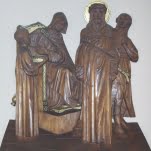 Jesus stands in the most human of places. He has already experienced profound solidarity with so many on this earth, by being beaten and tortured. Now he is wrongfully condemned to punishment by death. His commitment to entering our lives completely begins its final steps. He has said “yes” to God and placed his life in God’s hands. We follow him in this final surrender, and contemplate with reverence each place along the way, as he is broken and given for us.
Jesus stands in the most human of places. He has already experienced profound solidarity with so many on this earth, by being beaten and tortured. Now he is wrongfully condemned to punishment by death. His commitment to entering our lives completely begins its final steps. He has said “yes” to God and placed his life in God’s hands. We follow him in this final surrender, and contemplate with reverence each place along the way, as he is broken and given for us.
“You say that I am a king. For this I was born, and for this I have come into the world, to bear witness to the truth. Everyone who is of the truth hears my voice.”
Pilate said in answer: “What is truth?”
At this point, the Roman Procurator saw no need for further questions. He went to the Jews and told them: “I find no crime in him.” (John 18: 37-38)
The tragedy of Pilate is hidden in the question: What is truth? This was no philosophical question about the nature of truth, but an existential question about his own relationship with truth. It was an attempt to escape from the voice of conscience, which was pressing him to acknowledge the truth and follow it. When someone refuses to be guided by truth he is ultimately ready even to condemn an innocent person to death.
The accusers sense this weakness in Pilate and so do not yield. They relentlessly call for death by crucifixion. Pilate’s attempts at half measures are of no avail. The cruel punishment of scourging inflicted upon the Accused is not enough. When the Procurator brings Jesus, scourged and crowned with thorns, before the crowd, he seems to be looking for words which he thinks might soften the intransigence of the mob.
Pointing to Jesus he says: “Ecce homo!”. Behold the man!
But the answer comes back: “Crucify him, crucify him!”
Let us pray:
Lord Jesus Christ, you accepted an unjust judgment. Grant to us and to all the men and women of our time the grace to remain faithful to the truth. Do not allow the weight of responsibility for the sufferings of the innocent to fall upon us and upon those who come after us.
Stabat Mater:
At the Cross her station keeping, stood the mournful Mother weeping, close to Jesus to the last.
II Jesus takes up his cross
 Jesus is made to carry the cross on which he will die. It represents the weight of all our sins. What he must have felt as he first took it upon his shoulders! With each step he enters more deeply into our human experience. He walks in the path of human misery and suffering, and experiences its crushing weight.
Jesus is made to carry the cross on which he will die. It represents the weight of all our sins. What he must have felt as he first took it upon his shoulders! With each step he enters more deeply into our human experience. He walks in the path of human misery and suffering, and experiences its crushing weight.
It was not lawful to condemn a Roman citizen to death by crucifixion: it was too humiliating. The moment that Jesus of Nazareth took up the cross in order to carry it to Calvary marked a turning-point in the history of the cross. The symbol of a shameful death, reserved for the lowest classes, the cross becomes a key. From now on, with the help of this key, man will open the door of the deepest mystery of God. Through Christ’s acceptance of the cross, the instrument of his own self-emptying, men will come to know that God is love.
Love without limits: “God so loved the world that he gave his only Son, that whoever believes in him should not perish but have eternal life” (John 3:16).
This truth about God was revealed in the cross. Could it not have been revealed in some other way? Perhaps. But God chose the cross. The Father chose the cross for his Son, and his Son shouldered it, carried it to Mount Calvary and on it offered his life.
The cross is the sign of a love without limits!
Let us pray:
Lord Jesus Christ, who accepts the cross at the hands of men to make of it the sign of God’s saving love for humanity, grant us and all the men and women of our time the grace of faith in this infinite love. By passing on to the new millennium the sign of the cross, may we be authentic witnesses to the Redemption.
Stabat Mater:
Through her heart His sorrow sharing, all His bitter anguish bearing, now at length the sword has passed.
III Jesus falls the first time
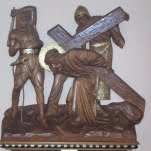 The weight of the cross is unbearable and Jesus falls under it – the first of three falls. How could he enter our lives completely without surrendering to the crushing weight of the life of so many on this earth! He lies on the ground and knows the experience of weakness beneath unfair burdens. He is pulled up and made to continue.
The weight of the cross is unbearable and Jesus falls under it – the first of three falls. How could he enter our lives completely without surrendering to the crushing weight of the life of so many on this earth! He lies on the ground and knows the experience of weakness beneath unfair burdens. He is pulled up and made to continue.
Jesus falls under the cross. This will happen three times along the comparatively short stretch of the “via dolorosa”. Exhaustion makes him fall. His body is stained with blood from the scourging, his head is crowned with thorns. All this causes his strength to fail. So he falls, and the weight of the cross crushes him to the ground.
We must go back to the words of the Prophet, who foresaw this fall centuries earlier. It is as though he were contemplating it with his own eyes: seeing the Servant of the Lord, on the ground under the weight of the cross, he tells us the real cause of his fall. It is this: “God laid on him the sins of us all”.
It was our sins that crushed the divine Condemned One to the ground. It was our sins that determined the weight of the cross that he carries on his shoulders. It was our sins that made him fall. With difficulty Christ gets up again to continue his journey. The soldiers escorting him urge him on with shouts and blows. After a moment the procession sets out again.
Let us pray:
O Christ, as you fall under the weight of our faults and rise again for our justification, we pray, help us and all who are weighed down by sin to stand up again and continue the journey. Give us the strength of the Spirit to carry with you the cross of our weakness.
Stabat Mater:
O how sad and sore distressed, was that Mother, highly blest, of the sole-begotten One.
IV Jesus meets his mother
 All his life, his mother had taught him the meaning of the words, “Behold, the handmaid of the Lord.” Now they look into each other’s eyes. How pierced-through her heart must be! How pained he must be to see her tears! Now, her grace-filled smile blesses his mission and stirs his heart to its depth. Love and trust in God bind them together.
All his life, his mother had taught him the meaning of the words, “Behold, the handmaid of the Lord.” Now they look into each other’s eyes. How pierced-through her heart must be! How pained he must be to see her tears! Now, her grace-filled smile blesses his mission and stirs his heart to its depth. Love and trust in God bind them together.
“Do not be afraid, Mary, for you have found favour with God. And behold, you will conceive in your womb and bear a son, and you shall call his name Jesus. He will be great, and will be called the Son of the Most High; and the Lord God will give to him the throne of his father David, and he will reign over the house of Jacob for ever; and his kingdom will have no end” (Luke 1:30-33).
Mary remembered these words. She often returned to them in the secret of her heart. When she met her Son on the Way of the Cross, perhaps these very words came to her mind with particular force. “He will reign… His kingdom will have no end”, the heavenly messenger had said.
Now, as she watches her Son, condemned to death, carrying the cross on which he must die, she might ask herself, all too humanly: So how can these words be fulfilled? In what way will he reign over the House of David? And how can it be that his kingdom will have no end? Humanly speaking, these are reasonable questions. But Mary remembered that, when she first heard the Angel’s message, she had replied: “Behold, I am the Handmaid of the Lord. May it be done to me according to your word” (Luke 1:38). Now she sees that her word is being fulfilled as the word of the cross. Because she is a mother, Mary suffers deeply.
But she answers now as she had answered then, at the Annunciation: “May it be done to me according to your word”. In this way, as a mother would, she embraces the cross together with the divine Condemned One. On the way of the cross Mary shows herself to be the Mother of the Redeemer of the world.
“All you who pass by the way, look and see whether there is any suffering like my suffering, which has been dealt me” (Lam 1:12). It is the Sorrowful Mother who speaks, the Handmaid who is obedient to the last, the Mother of the Redeemer of the world.
Let us pray:
O Mary, who walked the Way of the Cross with your Son, your mother’s heart torn by grief, but mindful always of your fiat and fully confident that He to whom nothing is impossible would be able to fulfil his promises, implore for us and for the generations yet to come the grace of surrender to God’s love. Help us, in the face of suffering, rejection, and trial, however prolonged and severe, never to doubt his love. To Jesus, your Son, honour and glory for ever and ever.
Stabat Mater:
Christ above in torment hangs, she beneath beholds the pangs, of her dying glorious Son.
V Simon of Cyrene helps Jesus carry the Cross
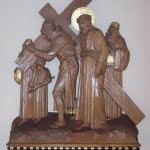 Jesus even experiences our struggle to receive help. He is made to experience the poverty of not being able to carry his burden alone. He enters into the experience of all who must depend upon others to survive. He is deprived of the satisfaction of carrying this burden on his own.
Jesus even experiences our struggle to receive help. He is made to experience the poverty of not being able to carry his burden alone. He enters into the experience of all who must depend upon others to survive. He is deprived of the satisfaction of carrying this burden on his own.
They compelled Simon (Mark 15:2 1). The Roman soldiers did this because they feared that in his exhaustion the Condemned Man would not be able to carry the cross as far as Golgotha. Then they would not be able to carry out the sentence of crucifixion.
They were looking for someone to help carry the cross. Their eyes fell on Simon. They compelled him to take the weight upon his shoulders. We can imagine that Simon did not want to do this and objected. Carrying the cross together with a convict could be considered an act offensive to the dignity of a free man. Although unwilling, Simon took up the cross to help Jesus.
Simon receives a gift. He has become “worthy” of it. What the crowd might see as an offence to his dignity has, from the perspective of redemption, given him a new dignity. In a unique way, the Son of God has made him a sharer in his work of salvation.
Is Simon aware of this? The evangelist Mark identifies Simon of Cyrene as the “father of Alexander and Rufus” (15:2 1). If the sons of Simon of Cyrene were known to the first Christian community, it can be presumed that Simon too, while carrying the cross, came to believe in Christ. From being forced, he freely accepted, as though deeply touched by the words: “Whoever does not carry his cross with me is not worthy of me.”
By his carrying of the cross, Simon was brought to the knowledge of the Gospel of the Cross. Since then, this Gospel has spoken to many, countless Cyreneans, called in the course of history to carry the cross with Jesus.
Let us pray:
O Christ, you gave to Simon of Cyrene the dignity of carrying your cross. Welcome us too under its weight, welcome all men and women and grant to everyone the gift of readiness to serve. Do not permit that we should turn away from those who are crushed by the cross of illness, loneliness, hunger or injustice. As we carry each other’s burdens, help us to become witnesses to the Gospel of the Cross and witnesses to you, who live and reign for ever and ever.
Stabat Mater:
Is there one who would not weep, whelmed in miseries so deep, Christ’s dear Mother to behold?
VI Veronica wipes the face of Jesus
 Jesus’ journey is at times brutal. He has entered into the terrible experiences of rejection and injustice. He has been whipped and beaten. His face shows the signs of his solidarity with all who have ever suffered injustice and vile, abusive treatment. He encounters a compassionate, loving disciple who wipes the vulgar spit and mocking blood from his face. On her veil, she discovers the image of his face – his gift to her. Something for us to contemplate forever.
Jesus’ journey is at times brutal. He has entered into the terrible experiences of rejection and injustice. He has been whipped and beaten. His face shows the signs of his solidarity with all who have ever suffered injustice and vile, abusive treatment. He encounters a compassionate, loving disciple who wipes the vulgar spit and mocking blood from his face. On her veil, she discovers the image of his face – his gift to her. Something for us to contemplate forever.
Veronica does not appear in the Gospels. Her name is not mentioned, even though the names of other women who accompanied Jesus do appear. It is possible, therefore, that the name refers more to what the woman did. In fact, according to tradition, on the road to Calvary a woman pushed her way through the soldiers escorting Jesus and with a veil wiped the sweat and blood from the Lord’s face. That face remained imprinted on the veil, a faithful reflection, a “true icon”. This would be the reason for the name Veronica. If this is so, the name which evokes the memory of what this woman did carries with it the deepest truth about her. One day, Jesus drew the criticism of onlookers when he defended a sinful woman who had poured perfumed oil on his feet and dried them with her hair. To those who objected, he replied: “Why do you trouble this woman? For she has done a beautiful thing to me… In pouring this ointment on my body she has done it to prepare me for burial” (Matthew 26:10, 12). These words could likewise be applied to Veronica.
Thus we see the profound eloquence of this event. The Redeemer of the world presents Veronica with an authentic image of his face.
The veil upon which the face of Christ remains imprinted becomes a message for us. In a certain sense it says: This is how every act of goodness, every gesture of true love towards one’s neighbour, strengthens the likeness of the Redeemer of the World in the one who acts that way.
Acts of love do not pass away. Every act of goodness, of understanding, of service, leaves on people’s hearts an indelible imprint and makes us ever more like the One who “emptied himself, taking the form of a servant” (Phil 2:7). This is what shapes our identity and gives us our true name.
Let us pray:
Lord Jesus Christ, you accepted a woman’s selfless gesture of love, and in exchange ordained that future generations should remember her by the name of your face. Grant that our works and the works of all who will come after us will make us like you and will leave in the world the reflection of your infinite love. To you, O Jesus, splendour of the Father’s glory, be praise and glory for ever.
Stabat Mater:
Can the human heart refrain, from partaking in her pain, in that Mother’s pain untold?
VII Jesus falls the second time
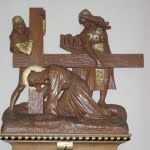 Even with help, Jesus stumbles and falls to the ground. In deep exhaustion he stares at the earth beneath him. “Remember, you are dust and to dust you will return.” He has seen death before. Now he can feel the profound weakness of disability and disease and aging itself, there on his knees, under the weight of his cross.
Even with help, Jesus stumbles and falls to the ground. In deep exhaustion he stares at the earth beneath him. “Remember, you are dust and to dust you will return.” He has seen death before. Now he can feel the profound weakness of disability and disease and aging itself, there on his knees, under the weight of his cross.
Here in the dust of the earth lies the Condemned One. Crushed by the weight of his cross. His strength drains away from him more and more. But with great effort he gets up again to continue his march.
To us sinners, what does this second fall say? More than the first one, it seems to urge us to get up, to get up again on our way of the cross.
It tells us that every person here below meets Christ who carries the cross and falls under its weight. In his turn, Christ, on the way to Calvary, meets every man and woman and, falling under the weight of the cross, does not cease to proclaim the good news.
For 2,000 years the Gospel of the Cross has spoken to man. For twenty centuries Christ, getting up again from his fall, meets those who fall.
Throughout these two millennia many people have learned that falling does not mean the end of the road. In meeting the Saviour they have heard his reassuring words: “My grace is sufficient for you; for my power is made perfect in weakness” (2 Cor 12:9). Comforted, they have gotten up again and brought to the world the word of hope which comes from the cross.
Let us pray:
Lord Jesus Christ, you fall under the weight of human sin and you get up again in order to take it upon yourself and cancel it. Give to us, weak men and women, the strength to carry the cross of daily life and to get up again from our falls, so that we may bring to future generations the Gospel of your saving power. To you, O Jesus, our support when we are weak, be praise and glory for ever.
Stabat Mater:
Bruised, derided, cursed, defiled, she beheld her tender child, all with blood scourges rent.
VIII Jesus speaks to the women of Jerusalem
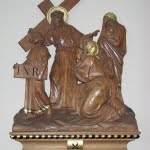 The women of Jerusalem, and their children, come out to comfort and thank him. They had seen his compassion and welcomed his words of healing and freedom. He had broken all kinds of social and religious conventions to connect with them. Now they are here to support him. He feels their grief. He suffers, knowing he can’t remain to help them more in this life. He knows the mystery of facing the separation of death.
The women of Jerusalem, and their children, come out to comfort and thank him. They had seen his compassion and welcomed his words of healing and freedom. He had broken all kinds of social and religious conventions to connect with them. Now they are here to support him. He feels their grief. He suffers, knowing he can’t remain to help them more in this life. He knows the mystery of facing the separation of death.
“Daughters of Jerusalem, do not weep for me, but weep for yourselves and for your children. For behold, the days are coming when they will say, ‘Blessed are the barren, and the wombs that never bore, and the breasts that never gave suck!’ Then they will begin to say to the mountains, ‘Fall on us’; and to the hills, ‘Cover us.’ For if they do this when the wood is green, what will happen when it is dry?” (Lk 23:28-31).
These are the words of Jesus to the women of Jerusalem who were weeping with compassion for the Condemned One.
“Do not weep for me, but weep for yourselves and for your children.” At the time it was certainly difficult to understand the meaning of these words. They contained a prophecy that would soon come to pass.
Shortly before, Jesus had wept over Jerusalem, foretelling the terrible fate that awaited the city. Now he seems to be referring again to that fate: “Weep for your children…”
Weep, because these, your very children, will be witnesses and will share in the destruction of Jerusalem, the Jerusalem which “did not know the time of her visitation” (cf. Lk 19:44).
If, as we follow Christ on the way of the cross, our hearts are moved with pity for his suffering, we cannot forget that admonition. “For if they do this when the wood is green, what will happen when it is dry?” For our generation, which has just left a millennium behind, rather than weep for Christ crucified, it is now the time for us to recognise “the time of our visitation”. Already the dawn of the resurrection is shining forth. “Behold, now is the acceptable time; behold, now is the day of salvation” (2 Cor 6:2).
To each of us Christ addresses these words of the Book of Revelation: “Behold, I stand at the door and knock; if any one hears my voice and opens the door, I will come in to him and eat with him, and he with me. He who conquers, I will grant him to sit with me on my throne, as I myself conquered and sat down with my Father on his throne” (3:20-21).
Let us pray:
O Christ, you came into this world to visit all those who await salvation. Grant that our generation will recognise the time of its visitation and share in the fruits of your redemption. Do not permit that there should be weeping for us and for the men and women of the new century because we have rejected our merciful Father’s outstretched hand.
Stabat Mater:
For the sins of His own nation, saw him hang in desolation, till his spirit forth he sent.
IX Jesus falls the third time
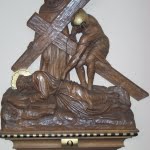 This last fall is devastating. Jesus can barely proceed to the end. Summoning all his remaining strength, supported by his inner trust in God, Jesus collapses under the weight of the cross. His executioners look at him as a broken man, pathetic yet paying a price he deserves. They help him up so he can make it up the hill of crucifixion.
This last fall is devastating. Jesus can barely proceed to the end. Summoning all his remaining strength, supported by his inner trust in God, Jesus collapses under the weight of the cross. His executioners look at him as a broken man, pathetic yet paying a price he deserves. They help him up so he can make it up the hill of crucifixion.
St Paul writes: “Though he was in the form of God, he did not count equality with God a thing to be grasped, but emptied himself taking the form of a servant, being born in human likeness. And being found in human form, he humbled himself and became obedient unto death, even death on a cross” (Phil 2:6-8). The third fall seems to express just this: the self-emptying the kenosis of the Son of God, his humiliation beneath the cross. Jesus had said to the disciples that he had come not to be served but to serve (cf. Matthew 20:28).
In the Upper Room, bending low to the ground and washing their feet, he sought, as it were, to prepare them for this humiliation of his. Falling to the ground for the third time on the way of the cross, he cries out loudly to us once more the mystery of himself. Let us listen to his voice! This Condemned Man, crushed to the ground beneath the weight of the cross, now very near the place of punishment, tells us: “I am the way, and the truth and the life” (John 14:6). “He who follows me will not walk in darkness, but will have the light of life” (John 8:12).
Let us not be dismayed by the sight of a condemned man, who falls to the ground exhausted under the cross. Within this outward sign of the death which is approaching the light of life lies hidden.
Let us pray:
Lord Jesus Christ, through your humiliation beneath the cross you revealed to the world the price of its redemption. Grant to the men and women of the third millennium the light of faith, so that, as they recognise in you the Suffering Servant of God and man, they may have the courage to follow the same path which, by way of the cross and self-emptying, leads to life without end.
Stabat Mater:
O thou Mother! fount of love! Touch my spirit from above, make my heart with thine accord.
X Jesus is stripped of his garments
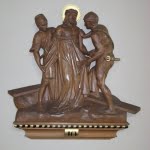 When they reached the place called Golgotha, they gave him wine to drink mixed with gall (myrrh, a narcotic), which he tasted, but would not drink. Part of the indignity is to be crucified naked. Jesus is completely stripped of any pride. The wounds on his back are torn open again. He experiences the ultimate vulnerability of the defenceless. No shield or security protects him. As they stare at him, his eyes turn to heaven.
When they reached the place called Golgotha, they gave him wine to drink mixed with gall (myrrh, a narcotic), which he tasted, but would not drink. Part of the indignity is to be crucified naked. Jesus is completely stripped of any pride. The wounds on his back are torn open again. He experiences the ultimate vulnerability of the defenceless. No shield or security protects him. As they stare at him, his eyes turn to heaven.
“When he tasted it, he would not drink it” (Matthew 27:34). He did not want a sedative, which would have dulled his consciousness during the agony. He wanted to be fully aware as he suffered on the cross, accomplishing the mission he had received from the Father.
That was not what the soldiers in charge of the execution were used to. Since they had to nail the condemned man to the cross, they tried to dull his senses and his consciousness. But with Christ this could not be. Jesus knows that his death on the cross must be a sacrifice of expiation. This is why he wants to remain alert to the very end. Without consciousness, he could not, in complete freedom, accept the full measure of suffering.
Behold, he must mount the cross, in order to offer the sacrifice of the New Covenant. He is the Priest. By means of his own blood, he must enter the eternal dwelling-places, having accomplished the world’s redemption (cf. Heb 9:12).
Conscience and freedom: these are the essential elements of fully human action.
The world has so many ways of weakening the will and of darkening conscience. They must be carefully defended from all violence. Even the legitimate attempt to control pain must always be done with respect for human dignity.
If life and death are to retain their true value, the depths of Christ’s sacrifice must be understood, and we must unite ourselves to that sacrifice if we are to hold firm.
Let us pray:
Lord Jesus, who, with supreme dedication, accepted death on the cross for our salvation, grant to us and to all the world’s people a share in your sacrifice on the cross, so that what we are and what we do may always be a free and conscious sharing in your work of salvation. To you, O Jesus, Priest and Victim, be honour and glory for ever.
Stabat Mater:
Make me feel as thou hast felt; make my soul to glow and melt, with the love of Christ my Lord.
XI Jesus is nailed to the cross
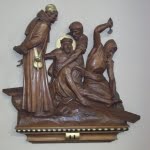 Huge nails are hammered through his hands and feet to fix him on the cross. He is bleeding much more seriously now. As the cross is lifted up, the weight of his life hangs on those nails. Every time he struggles to pull himself up to breathe, his ability to cling to life slips away.
Huge nails are hammered through his hands and feet to fix him on the cross. He is bleeding much more seriously now. As the cross is lifted up, the weight of his life hangs on those nails. Every time he struggles to pull himself up to breathe, his ability to cling to life slips away.
“They tear holes in my hands and my feet; I can count every one of my bones” (Ps 21:17-18). The words of the Prophet are fulfilled. The execution begins. The torturers’ blows crush the hands and feet of the Condemned One against the wood of the cross. The nails are driven violently into his wrists. Those nails will hold the condemned man as he hangs in the midst of the inexpressible torments of his agony. In his body and his supremely sensitive spirit, Christ suffers in a way beyond words.
With him there are crucified two real criminals, one on his right, the other on his left. The prophecy is fulfilled: “He was numbered among the transgressors” (Is 53:12).
Once the torturers raise the cross, there will begin an agony that will last three hours. This word too must be fulfilled: “When I am lifted up from the earth, I will draw all people to myself” (Jn 12:32).
What is it that “draws” us to the Condemned One in agony on the cross? Certainly the sight of such intense suffering stirs compassion. But compassion is not enough to lead us to bind our very life to the One who hangs on the cross.
How is it that, generation after generation, this appalling sight has drawn countless hosts of people who have made the cross the hallmark of their faith? Hosts of men and women who for centuries have lived and given their lives looking to this sign?
From the cross, Christ draws us by the power of love, Divine Love, which did not recoil from the total gift of self; infinite Love, which on the tree of the cross raised up from the earth the weight of Christ’s body, to counterbalance the weight of the first sin; boundless Love, which has utterly filled every absence of love and allowed humanity to find refuge once more in the arms of the merciful Father.
May Christ lifted high on the cross draw us too, the men and women of the new millennium! In the shadow of the cross, let us “walk in love, as Christ loved us and gave himself up for us, a fragrant offering and sacrifice to God” (Eph 5:2).
Let us pray:
O Christ lifted high, O Love crucified, fill our hearts with your love, that we may see in your cross the sign of our redemption and, drawn by your wounds, we may live and die with you, who live and reign with the Father and the Spirit, now and for ever.
Stabat Mater:
Holy Mother! pierce me through, in my heart each wound renew, of my Saviour crucified.
XII Jesus dies on the cross
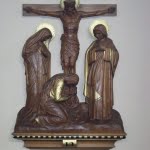 Between two criminals, a mocking title above his head, with only Mary and John and Mary Magdalene to support him, Jesus surrenders his last breath: “Into your hands I commend my spirit.”
Between two criminals, a mocking title above his head, with only Mary and John and Mary Magdalene to support him, Jesus surrenders his last breath: “Into your hands I commend my spirit.”
“Father, forgive them, for they know not what they do” (Lk 23:34). At the height of his Passion, Christ does not forget man, especially those who are directly responsible for his suffering. Jesus knows that more than anything else man needs love; he needs the mercy which at this moment is being poured out on the world.
“Truly, I say to you, today you will be with me in Paradise” (Lk 23:43). This is how Jesus replies to the plea of the criminal hanging on his right: “Jesus, remember me when you come into your kingdom” (Lk 23:42). The promise of a new life. This is the first fruit of the Passion and imminent Death of Christ. A word of hope to man.
At the foot of the cross stood Mary, and beside her the disciple, John the Evangelist. Jesus says: “Woman, behold your son!” and to the disciple: “Behold your mother!” (Jn 19:26-27). “And from that moment the disciple took her to his own home” (Jn 19:27). This is his bequest to those dearest to his heart. His legacy to the Church. The desire of Jesus as he dies is that the maternal love of Mary should embrace all those for whom he is giving his life, the whole of humanity.
Immediately after, Jesus cries out: “I am thirsty” (Jn 19:28). A word which describes the dreadful burning which consumes his whole body. It is the one word which refers directly to his physical suffering.
Then Jesus adds: “My God, my God, why have you abandoned me?” (Mt 27:46;
cf. Ps 22:2). These words of the Psalm are his prayer. Despite their tone, these words reveal the depths of his union with the Father. In the last moments of his life on earth, Jesus thinks of the Father. From this moment on, the dialogue will only be between the dying Son and the Father who accepts his sacrifice of love.
When the ninth hour comes, Jesus cries out: “It is accomplished!” (Jn 19:30). Now the work of the redemption is complete. The mission, for which he came on earth, has reached its goal.
The rest belongs to the Father: “Father, into your hands I commit my spirit” (Lk 23:46). And having said this, he breathed his last. “The curtain of the temple was torn in two…” (Mt 27:51). The “Holy of Holies” of the Jerusalem Temple is opened at the moment when it is entered by the Priest of the New and Eternal Covenant.
Let us pray:
Lord Jesus Christ, in the moment of your agony you were not indifferent to humanity’s fate, and with your last breath you entrusted to the Father’s mercy the men and women of every age, with all their weaknesses and sins. Fill us and the generations yet to come with your Spirit of Love, so that our indifference will not render vain in us the fruits of your death. To you, crucified Jesus, the wisdom and the power of God, be honour and glory for ever and ever.
Stabat Mater:
Let me share with thee His pain, who for all my sins was slain, who for me in torments died.
XIII Jesus is taken down from the cross
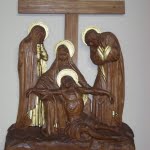 What tender mourning! Jesus’ lifeless body lies in his mother’s arms. He has truly died. A profound sacrifice, complete.
What tender mourning! Jesus’ lifeless body lies in his mother’s arms. He has truly died. A profound sacrifice, complete.
In the arms of his Mother they have placed the lifeless body of the Son. The Gospels say nothing of what she felt at that moment. It is as though by their silence the Evangelists wished to respect her sorrow, her feelings and her memories. Or that they simply felt incapable of expressing them. It is only the devotion of the centuries that has preserved the figure of the “Pietà”, providing Christian memory with the most sorrowful image of the ineffable bond of love which blossomed in the Mother’s heart on the day of the Annunciation and ripened as she waited for the birth of her divine Son.
That love was revealed in the cave at Bethlehem and was tested already during the Presentation in the Temple. It grew deeper as Mary stored and pondered in her heart all that was happening (cf. Lk 2:51). Now this intimate bond of love must be transformed into a union which transcends the boundary between life and death.
And thus it will be across the span of the centuries: people pause at Michelangelo’s statue of the Pietà, they kneel before the image of the loving and sorrowful Mother (Smetna Dobrodziejka) in the Church of the Franciscans in Krakow, before the Mother of the Seven Sorrows, Patroness of Slovakia, they venerate Our Lady of Sorrows in countless shrines in every part of the world. And so they learn the difficult love which does not flee from suffering, but surrenders trustingly to the tenderness of God, for whom nothing is impossible (cf. Lk 1:37).
Let us pray:
Implore for us the grace of faith, hope and charity, so that we, like you, may stand without flinching beneath the cross until our last breath. To your Son, Jesus, our Saviour, with the Father and the Holy Spirit, all honour and glory for ever and ever.
Stabat Mater:
Let me mingle tears with thee, mourning Him who mourned for me, all the days that I may live.
XIV Jesus is laid in the tomb
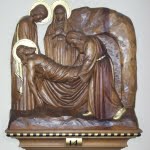 They take the body of Jesus to its resting place. The huge stone over the tomb is the final sign of the permanence of death. In this final act of surrender, who would have imagined this tomb would soon be empty or that Jesus would show himself alive to his disciples, or that they would recognize him in the breaking of bread? Oh, that our hearts might burn within us, as we realise how he had to suffer and die so as to enter into his glory, for us.
They take the body of Jesus to its resting place. The huge stone over the tomb is the final sign of the permanence of death. In this final act of surrender, who would have imagined this tomb would soon be empty or that Jesus would show himself alive to his disciples, or that they would recognize him in the breaking of bread? Oh, that our hearts might burn within us, as we realise how he had to suffer and die so as to enter into his glory, for us.
“He was crucified, died and was buried…” The lifeless body of Christ has been laid in the tomb. But the stone of the tomb is not the final seal on his work. The last word belongs not to falsehood, hatred and violence. The last word will be spoken by love, which is stronger than death.
“Unless a grain of wheat falls into the earth and dies, it remains alone; but if it dies, it bears much fruit” (Jn 12:24). The tomb is the last stage of Christ’s dying through the whole course of his earthly life; it is the sign of his supreme sacrifice for us and for our salvation.
Very soon this tomb will become the first proclamation of praise and exaltation of the Son of God in the glory of the Father.
“He was crucified, died and was buried, … on the third day he rose from the dead”.
Once the lifeless body of Jesus is laid in the tomb, at the foot of Golgotha, the Church begins the vigil of Holy Saturday. In the depths of her heart, Mary stores and ponders the Passion of her Son; the women agree to meet on the morning of the day after the Sabbath, in order to anoint Christ’s body with aromatic ointments; the disciples gather in the seclusion of the Upper Room, waiting for the Sabbath to pass.
This vigil will end with the meeting at the tomb, the empty tomb of the Saviour. Then the tomb, the silent witness of the Resurrection, will speak. The stone rolled back, the inner chamber empty, the cloths on the ground, this will be what John sees when he comes to the tomb with Peter: “He saw and he believed” (Jn 20:8). And with him the Church believed, and from that moment she never grows weary of communicating to the world this fundamental truth of her faith: “Christ has been raised from the dead, the first fruits of those who have fallen asleep” (1 Cor 15:20).
The empty tomb is the sign of the definitive victory of truth over falsehood, of good over evil, of mercy over sin, of life over death. The empty tomb is the sign of the hope which “does not deceive” (Rom 5:5). “[Our] hope is full of immortality” (cf. Wis 3:4).
Let us pray:
Lord Jesus Christ, by the power of the Holy Spirit, you were drawn by the Father from the darkness of death to the light of a new life in glory. Grant that the sign of the empty tomb may speak to us and to future generations and become a wellspring of living faith, generous love, and unshakeable hope. To you, O Jesus, whose presence, hidden and victorious, fills the history of the world, be honour and glory for ever and ever.
Stabat Mater:
By the Cross with thee to stay, there with thee to weep and pray, is all I ask of thee to give.